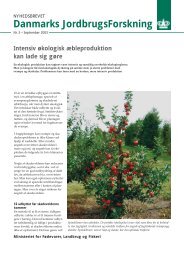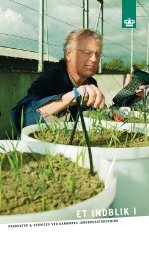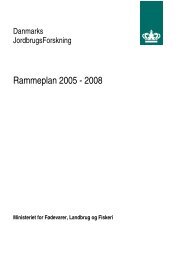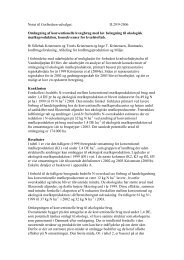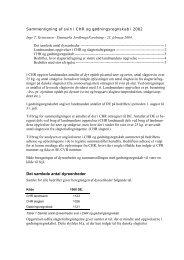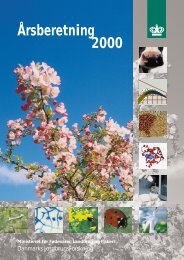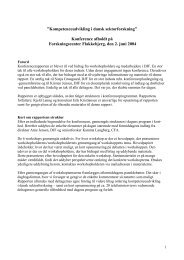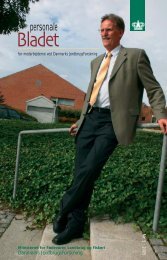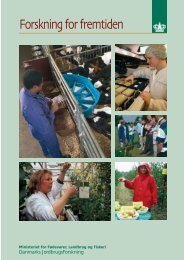- Paper III - between the 14 herds. As system differences previously have shown to influence the results <strong>of</strong> human approach tests (Marchant-Forde et al., 2003), the between-herd variation should be interpreted with caution. For managers <strong>of</strong> herds with <strong>group</strong> <strong>housed</strong> sows, information <strong>of</strong> the sows' condition would be very useful in relation to analysing <strong>and</strong> improving animal welfare <strong>and</strong> perhaps also productivity. Since it is likely that the sows’ general condition, to a large extent is influenced by management related factors, it may be difficult to predict the presence <strong>of</strong> e.g. stress, fear <strong>and</strong> unequal feed intake merely on the knowledge <strong>of</strong> layout related factors like feeding system <strong>and</strong> escape possibilities. Therefore, it seems important that managers are able to make an on site judgement <strong>of</strong> the sows’ condition. The indicators presented in this paper are possible to perform in practice, <strong>and</strong> taken together the results indicate that they could be relevant indicators <strong>of</strong> social stress, fear <strong>and</strong> feed intake. As a consequence, these indicators might be relevant ingredients <strong>of</strong> a management tool to analyse <strong>and</strong> improve the welfare <strong>and</strong> productivity <strong>of</strong> <strong>group</strong> <strong>housed</strong> sows. Acknowledgements The authors wish to thank the participating farmers <strong>and</strong> the technicians Henrik K. Andersen, Kristine R. Hansen, Michael Hansen, Orla Nielsen, Niels H. Thomsen, <strong>and</strong> Helge Yde for their much appreciated assistance in carrying out the data collection. The authors also wish to express their gratitude to Erik Jørgensen for valuable contributions to the statistical analyses. 82
References - Paper III - Andersen, I.L. 2003. Ph.D. Department <strong>of</strong> Animal <strong>and</strong> Aquacultural Sciences, Agricultural University <strong>of</strong> Norway, P.P. Box 5065, 1432 Aas, Norway. Personal communication. Andersen, I.L. & Bøe, K.E. 1999. Straw bedding or concrete floor for loose-<strong>housed</strong> pregnant sows: Conse- quences for aggression, production <strong>and</strong> physical health. Acta Agric. Sc<strong>and</strong>., Sect. A, Anim. Sci. 49, 190-195. Andersen, I.L., Bøe, K. & Kristiansen, A.L. 1999. The influence <strong>of</strong> different feeding arrangements <strong>and</strong> food type on competition at feeding in pregnant sows. Appl. Anim. Behav. Sci. 65, 91-104. Andersen, I.L., Berg, S., Bøe, K.E. & Edwards, S. 2003. Effect <strong>of</strong> short term h<strong>and</strong>ling on fear <strong>of</strong> humans <strong>and</strong> the consequences for maternal abilities <strong>of</strong> sows. Proceedings <strong>of</strong> the 37th International Congress <strong>of</strong> the ISAE, Abano Terme, Italy, June 24-28, 2003. Abstract, Pp. 79 Arey, D. & Edwards, S.A. 1998. Factors influencing aggression between sows after mixing <strong>and</strong> the concequences for welfare <strong>and</strong> production. Livest. Prod. Sci. 56, 61-70. Barnett, J.L., Cronin, G.M. & Winfield, C.G. 1981. The effects <strong>of</strong> individual <strong>and</strong> <strong>group</strong> penning <strong>of</strong> pigs on total <strong>and</strong> free plasma corticosteroids <strong>and</strong> the maximum corticosteroid binding capacity. Gen. Comp. Endocrinol., 44, 219-225. Barnett, J.L., Cronin, G.M., Winfield, C.G. & Dewar, A.M. 1984. The welfare <strong>of</strong> adult pigs: the effects <strong>of</strong> five housing treatments on behaviour, plasma corticosteroids <strong>and</strong> injuries. Appl. Anim. Behav. Sci. 12, 209-232. Barnett, J.L., Hemsworth, P.H., Cronin, G.M., Newman, E.A., McCallum, T.H. & Chilton, D. 1992. Effects <strong>of</strong> pen size, partial stalls <strong>and</strong> method <strong>of</strong> feeding on welfare-related behavioural <strong>and</strong> physiological responses <strong>of</strong> <strong>group</strong>-<strong>housed</strong> pigs. Appl. Anim. Behav. Sci34, 207-220. Baustad, B. & Lium, B. 2002. Helse og dyrevelferd i norsk svineproduksjon sett i et internasjonalt perspektiv. Norsk Vet. tidsskrift 114, 87-91. Bonde, M., 2003. Welfare Assessment in a Commercial Sow herd. Development, evaluation <strong>and</strong> report <strong>of</strong> the method. Revised reprint <strong>of</strong> PhD thesis by Marianne Kjær Bonde. DIAS Report 46 (Animal Husb<strong>and</strong>ry). Danish Institute <strong>of</strong> Agricultural Sciences. 98pp. Bonde, M., Rousing, T. & Sørensen, J.T. 2003. Human approach test for on-farm use in loose-<strong>housed</strong> pregnant sows: relation between behaviour <strong>and</strong> health. Proceedings <strong>of</strong> the 37th International Congress <strong>of</strong> the ISAE, Abano Terme, Italy, June 24-28, 2003. Abstract, pp. 81. Bradshaw, R.H., Skyrme, J., Brenninkmiejer, E.E. & Broom, D.M. 2000. Consistency <strong>of</strong> measurement <strong>of</strong> social status in dry-sows <strong>group</strong>-<strong>housed</strong> in indoor <strong>and</strong> outdoor systems. Anim. Welfare 9, 75-79. Brouns, F. & Edwards, S.A. 1994. Social rank <strong>and</strong> feeding behaviour <strong>of</strong> <strong>group</strong>-<strong>housed</strong> sows fed competitively or ad libitum. Appl. Anim. Behav. Sci39, 225-235. Brouns, F., Edwards, S.A. & English, P.R. 1991. Fibrous raw materials in sow diets: Effects on voluntary food intake, digestibility <strong>and</strong> diurnal activity patterns. Anim. Prod. 52, 598. 83
- Page 1 and 2:
Reproduction performances and condi
- Page 4:
Contents Summary………………
- Page 7 and 8:
Paper II - Summary - A review of 15
- Page 10 and 11:
- Sammendrag - SAMMENDRAG Antallet
- Page 12:
- Sammendrag - søgt. Positive korr
- Page 15 and 16:
- Background and aim - systems and
- Page 18:
- Outline of this thesis - OUTLINE
- Page 21 and 22:
- How does group housing vary in pr
- Page 23 and 24:
- How does group housing vary in pr
- Page 26 and 27:
- Paper I - Effect of energy intake
- Page 28 and 29: - Paper I - 1. Introduction The num
- Page 30 and 31: - Paper I - Therefore, the aim of t
- Page 32 and 33: Refer ence Table 1. Effect of energ
- Page 34 and 35: - Paper I - Therefore, low energy s
- Page 36 and 37: Table 2. Effect of energy intake in
- Page 38 and 39: - Paper I - However, this does not
- Page 40 and 41: Table 3. Effect of energy intake in
- Page 42 and 43: - Paper I - Feeding sows 16, 27 or
- Page 44 and 45: - Paper I - gonadotrophins (LH, FSH
- Page 46 and 47: - Paper I - the first four weeks af
- Page 48 and 49: - Paper I - Cosgrove, J.R., Foxcrof
- Page 50 and 51: - Paper I - Matschke, G.H., 1964. T
- Page 52: - Paper I - Tribble, L.F., Orr, D.E
- Page 55 and 56: - Paper III - Indicators of feed in
- Page 57 and 58: - Paper III - 1. Introduction The n
- Page 59 and 60: Table 1. Applied feeding and housin
- Page 61 and 62: - Paper III - performed. The sow ha
- Page 63 and 64: - Paper III - proximately three wee
- Page 65 and 66: - Paper III - Table 3. Overall mean
- Page 67 and 68: Table 5. Correlations between all c
- Page 69 and 70: Back fat W, mm Back fat gain, AM-F,
- Page 71 and 72: - Paper III - from three weeks afte
- Page 73 and 74: - Paper III - Number of skin lesion
- Page 75 and 76: - Paper III - In herds practising g
- Page 77: - Paper III - Previous work have fo
- Page 81 and 82: - Paper III - Kongsted, A.G. 2004a.
- Page 83 and 84: - Paper IV - Relation between repro
- Page 85 and 86: - Paper IV - 1. Introduction Group
- Page 87 and 88: - Paper IV - ing compared to number
- Page 89 and 90: - Paper IV - mixed model using the
- Page 91 and 92: Table 2. Estimates and standard err
- Page 93 and 94: - Paper IV - cial effect on high ra
- Page 95 and 96: References - Paper IV - Aherne, F.X
- Page 97 and 98: - Paper IV - Olsson, A.-C., Svendse
- Page 99 and 100: - General discussion - GENERAL DISC
- Page 101 and 102: - General discussion - However, an
- Page 103 and 104: References - General discussion - A
- Page 105 and 106: - Conclusions - 6. CONCLUSIONS Two
- Page 107 and 108: - Appendix 1 - APPENDIX 1 LITTER SI
- Page 109 and 110: - Appendix 1 - they are mature i.e.
- Page 111 and 112: - Appendix 1 - Soon after ovulation
- Page 113 and 114: - Appendix 1 - Crombie, P.L., 1970.
- Page 115: - Appendix 1 - Scott, M.A., 2000. A




